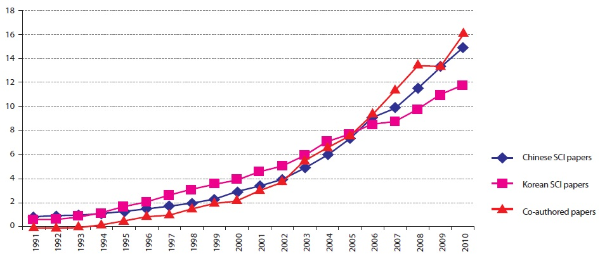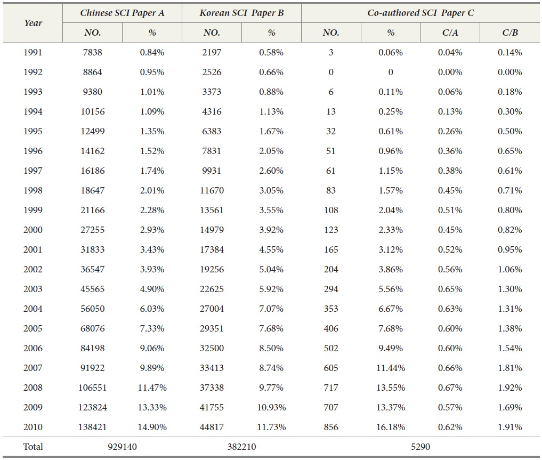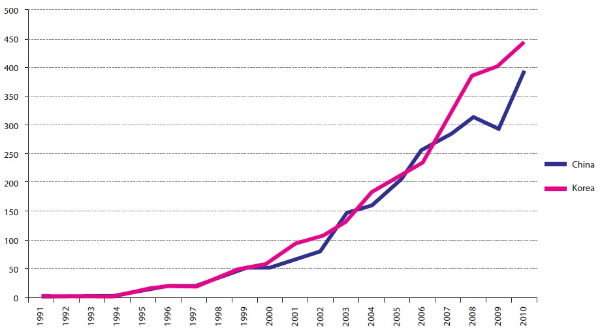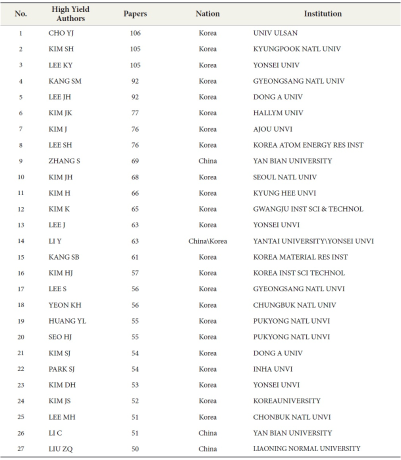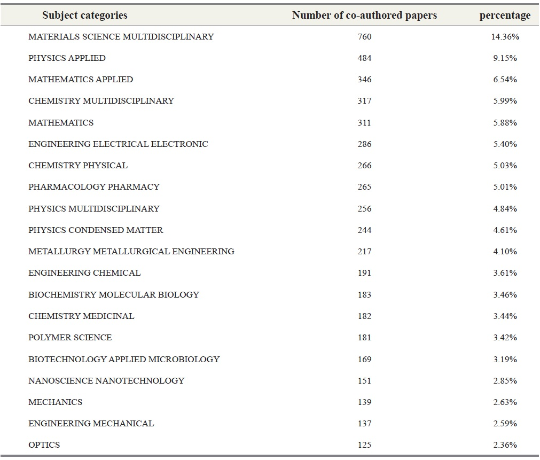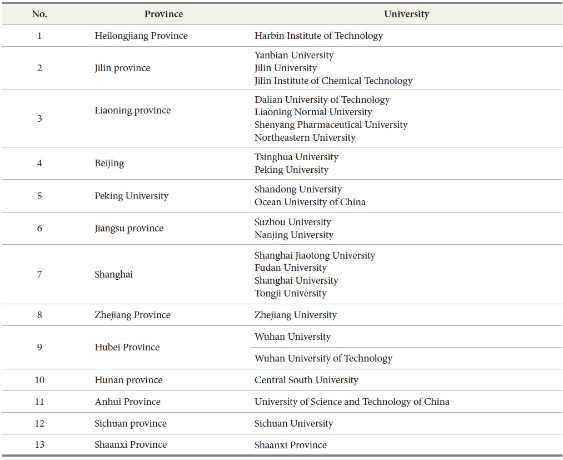ISSN : 2287-9099
Sino-South Korean Scientific Collaboration Based On Co-Authored SCI Papers

Chunlin Jiang (Institute of Science of Science and S&T Management Dalian University of Technology)

Abstract
Using statistic and bibliometric methods to characterize scientific cooperation between China (excluding Hong Kong, Macao, and Taiwan) and South Korea through their bilateral co-authored papers covered by the Science Citation Index CD-ROM, 1991-2010, in our paper we exploit the feature of their cooperation in four levels: time sequence, academic community, key fields, and institution distribution. From the time sequence we know that collaboration between China and Korea starts in 1991, reaching the first peak during 2004-2007. As for the academic community, the number of Chinese corresponding authors (2414) is slightly lower than that of Korea (2700). Regarding the 27 high yield authors, there are only 4 coming from China. Korea has a higher active level than Chinese authors. China and Korea tend to cooperate with each other on strong disciplines such as physics, chemistry, material science, engineering, mathematics, pharmaceutical, computer science and biology. Furthermore, they also attach great importance to basic research and high-tech cooperation. Besides, Chinese Academy of Sciences ranks at the top 1 among the distribution of institutions. As a majority of the collaborative institutions are universities, the participation of non-university institutions is relatively low. There are 7 Korean universities among the top ten institutions, while Yanbian University and Tsinghua University in China rank respectively as third and fourth. Seoul National University, accompanied by Korea University and Yonsei University as the three top Korean universities, is also among the top among the cooperating institutions.
- keywords
- Bibliometric Methods, Sino-South Korean, Scientific Collaboration, SCI paper
1. INTRODUCTION
Since China and South Korea (hereafter “Korea”) established diplomatic relations in politics on August 24, 1992, the two countries have kept intensive contact with each other in economic, scientific, educational, and cultural fields. The signing of the “scientific cooperation between China and Korea protocol” in September 1992 witnessed the beginning of scientific cooperation between the two countries. Since then the leaders of the two countries positively promote deep and wide scientific collaboration through various policy supports. Besides, both China and Korea are devoted to strengthening private activities among enterprises, universities, and research institutions. To raise the high quality of international scientific research personnel and to improve educational levels, the two countries continually promote cooperation by running research projects. Chongqing University of Posts and Telecommunications, accompanying Korea universities such as Inha University, Sun Moon University, and Konkuk University, has carried out scientific cooperation for 14 years (Lee, 2009). All of the universities have not only yielded substantial achievements, but also accumulated valuable experiences about international scientific cooperation. Research institutions’ collaboration was various in forms, such as establishing joint research centers, participating in joint research projects, and exchanging scientific tours. As of March 25, 2012, China has published 929,220 SCI papers during 1991-2010, with Korea publishing 382,243. The USA accounts for the highest proportion, followed by Japan, Germany, Britain, Canada, Australia, France, Singapore, and South Korea. Korea ranks in the top 9 from the Chinese international scientific collaborative view. The USA accounts for 13.58% in Korean scientific collaboration, higher than the proportion of USA-China cooperation, followed by Japan, China, Germany, Canada, Britain, India, Russia, and France. China ranks in the top 3 from the Korean international scientific collaborative view. China has become an important scientific collaboration partner of Korea.
In an earlier study on international scientific collaboration, Frame and Carpenter(1979) found that the size of a national scientific effort, and a number of extra-science factors such as history, geography, politics and language, all play a strong role in determining how much international collaboration occurs and who collaborates with whom in the international scientific community. That is, scientific collaboration easily takes place between countries which are geographically close and share historical and linguistic backgrounds (Choi, 2012). China and South Korea are neighbors, facing each other across the sea with a friendly traditional relationship. What is more, the two countries are not only regionally close, but are both influenced by Confucian culture which makes them having similar values and cultural identities. Therefore the two countries have a good foundation to collaborate with each other.
There is growing interest in researching international scientific collaboration between China and other countries, such as the United States (Suttmeier, 2008; Tang & Shapira, 2011), and Russia, France, Japan, Europe, and South Korea. As for Sino-South Korean scientific collaboration, Kim (1999) characterized international scientific cooperation in Korea through the numbers of internationally co-authored papers covered by the SCI CD-ROM, 1994-1996. During this period, the country with the highest rate of cooperation with Korea is the USA (42%), followed by Japan, Italy, Germany, the UK, and France. Kim (2005) has also investigated Korean science and international collaboration during 1995 to 2000 through an analysis of journal publications. From the paper we know that among the top-ten collaborating countries, only the Chinese and the Canadians’ share of collaborative publications with Korea increased between the two periods under consideration. China ranked number four in the distribution of Korea’s international partners, followed by the USA, Japan, and Germany. Kim H.-N. et al (2012) investigated the agricultural innovation systems of Korea and China from the perspective of triple helix innovation. Kim (2007) has analyzed the effectiveness of Korea’s Biotechnology Stimulation Plans, with a comparison with four other Asian nations, referring to China. Haustein et al (2011) focused on eleven countries in the Asia-Pacific region including Australia, China, Indonesia, Japan, Malaysia, New Zealand, Singapore, South Korea, Taiwan, Thailand and Vietnam by evaluating their national research output with the help of bibliometric indicators in particular.From the literature review, we can see that there are not enough papers to study the scientific cooperation between China and Korea compared to the necessity of research including region adjacency, trade frequency, and cultural similarity. Furthermore, the papers studied the collaboration condition mainly from qualitative aspects which limit our specific and objective understanding. In our paper, we exploit the key area and characteristic of their collaboration in four levels: time sequence, academic community, key fields, and institution distribution for the better presentation of new characteristics between China and South Korea, 1991-2010.
2. DATA AND METHOD
Data were collected from the Web of Science during the period 1991-2010 through the numbers of their bilateral co-authored papers. The ‘bilateral cooperation papers’ are defined as all of the authors with an address in Korea or China so that it can reflect the interests and trends between the two countries precisely.
Co-authorship of scientific publications is easy to compute and obviously linked to collaboration (Giuliani et al, 2010). Scientific cooperation between countries is a kind of abstract relation, essentially, which requires an effective method to measure. Under this circumstance, the co-authored scientific publications are a way to measure the collaboration between countries to some extent. Therefore we retrieved the bilateral co-authored papers covered by the Science Citation Index CD-ROM to characterize scientific cooperation between China and Korea using statistic and bibliometric methods for 1991-2010.
3. RESULTS AND DISCUSSION
From the time sequence of the co-authored SCI papers, we can see that collaboration between China and Korea starts in 1991. The relatively small share of Korean international collaboration with China can be partially explained by the isolation of Chinese science from the international community (Kim, 2005). Mainly thanks to government policy support, the collaboration between the two countries attained a high growth rate during 2006-2007. From the Chinese side, the “national long-term plan for science and technology (2006-2020)” and the “eleventh five-year plan” put forward the national independent innovation strategy which plays a very important role in the number of Chinese SCI papers. In 2006, the “eleventh five-year plan” promulgated by the Ministry of Science and Technology makes it clear that it is of great need to further bilateral cooperation with Europe, America, Japan, Korea and other countries aiming at achieving substantial achievements in basic research, scientific frontiers, high technology, related industries, and so on etc.
From the Korean side, just as the figure above show, the Korea government has increased fund support of international project since 1996, reaching a peak during 2004-2007. The flow of government funds played a guiding part in Korea international scientific collaboration. To some extent, it contributes to the increase of the scientific cooperation between China and Korea.
In order to see the yearly distribution of their SCI papers from a more intuitive perspective, we make statistics for the number of Chinese, Korean, and co-authored papers respectively, named A, B, C. We define C/A as the proportion that co-authored SCI papers account for Chinese SCI papers. In the same way, C/B means the proportion that co-authored SCI papers account for Korean SCI papers. The number of Chinese SCI papers adds up to 929,140, while Korea is 382,210, the co-authored is 5,290, and the percentage of co-authored papers accounts for 0.57% and 1.38% separately. It suggests that the proportion of Korea in China’s scientific collaboration is much smaller comparing China in Korea. That means China is becoming a more important scientific partner in Korean scientific collaboration territory. Actually, there are great potentials for their further cooperation. From the table below we know that the number of co-authored papers in Korean SCI papers exceeded 1% since 2002 for the first time, reaching 1.91% in 2010. It suggests that China has increasingly become an important scientific cooperation partner of Korea. In 2006, the number of Chinese SCI papers exceeded Korean for the first time and maintained a high growth rate until 2010. The co-authored SCI papers maintained the same growth rate with each of the two countries over time, 2006 in particular, indicating the development of their cooperation. In addition, we could not ignore that Chinese SCI papers are superior in number compared to Korea during this time.
4. THE ACADEMIC COMMUNITY OF CO-AUTHORED SCI PAPERS
As we all know, the number of papers is not the only indicator to measure scientific contribution. The number of corresponding authors is also important for reflecting the status of each country in scientific cooperation. Thus we put forward the bilateral cooperation dominant-subordinate rate, which means the number of the country identification of the first author accounting for the total amount of the co-authored papers. If the ratio is more than 50%, it indicates that the country is in a dominant position in scientific cooperation. If the ratio is less than 50%, it indicates that the country in a subordinate status. In view of the example of English literature, we take the corresponding author as our target according to English author arrangement practice. Therefore, in the ratio above, corresponding author equals to the first author. Results show that the number of Chinese corresponding authors (2,414) is slightly lower than that of Korea’s (2,700), with the dominant-subordinate rate 45.63% and 51.04%, respectively. Korea has a slight advantage over China in their scientific collaboration. Through the corresponding author’s annual distribution, we can find that in the period 1991-2000, corresponding authors are few in number, and the coincidence curve almost shows that the two countries are in the same position. In the period 2002-2006, the curve shows that both countries are dominant. After 2006, Korea is gradually in the leading position, while China has narrowed the gap considerably since 2009.
In addition to the corresponding authors, we also take the highly productive authors as our statistical object. Of our data, authors who published 50 papers or above in the data set are analyzed. Among the 27 high yield authors, there are only 4 coming from China. The unbalanced distribution demonstrates different activity levels of the two countries in scientific co-operation. The high activity level of Korea indicates that it is inclined to choose Chinese authors as research partners. Besides, most of the highly productive authors come from university settings. A partial explanation for the markedly high research output from academic institutions may be that university researchers aim to publish much of their work in prestigious international journals (Kim, 2005).
5. KEY FIELDS OF SCIENTIFIC COOPERATION
In this section, we use the subject category of the co-authored papers to search for their key fields. We choose the WoS (Web of Science) subject category mainly because of the data source. In the meantime, we take the Essential Science Indicators (ESI) which can evaluate the subject influence through the ranking from the Papers, Citations, and Citations per paper level as our accessory appliances. The ESI has been updated as of November 1, 2012 to cover a 10-year plus 8-month period, January 1, 2002-August 31, 2012. Therefore, we have retrieved the data spanning 2002.01.01 to 2010.12.31 for the sake of subject ranking. Due to the subject category differences between Web of Science and ESI, we have to integrate the two methods. This distinction has been presented specifically in Table 3. The left part shows the top 10 subjects which are based on WoS, while the right part ranking is based on the ESI.
According to the statistics of SCI subject classification, we find that the discipline of scientific cooperation mainly focuses on material science, physics, chemistry, mathematics, pharmaceutical, and metallurgical engineering. The physical field can also be divided into applied physics, physical chemistry, and multidisciplinary physics. In the field of mathematics, both basic mathematics and applied mathematics are included.
Studies show that scientific cooperation between countries mainly concentrates on their own strong fields, followed by a country’s strong discipline, and rarely in their weak research fields (Z.Michel et al, 2000). Through ESI subject evaluation, we can see that the discipline which China and Korea cooperate with each other in has a high world rank as well. It is in keeping with the previous studies that the scientific cooperation of the two countries is mainly in strong research fields for both. In addition, the citations per paper of Korea are higher than that of China in physics, materials science, and chemistry.
Table 3.
Discipline Distribution of Co-authored SCI Papers
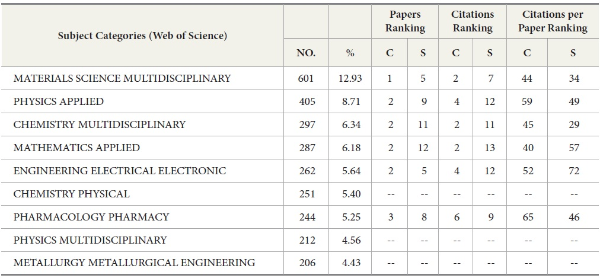
Note. C is short for China; S is short for Korea; ‘--’ means no data.
Generally, basic subjects (mathematics, logic, astronomy and astrophysics, earth science and space science, physics, chemistry, life science) are more inclined to cooperation than applied subjects (Kim, 2005). The rule gets perfect interpretation in Chinese and Korean scientific cooperation. Mathematics, physics, chemistry, and biology, etc. account for a large proportion in scientific cooperation. The two countries both attach great importance to the basic research field, so as to lay a solid foundation to build an innovative country system. The Korean government spares no effort to strengthen basic innovation research investment for keeping up with the pace of developed countries. Basic research investment in 2009 accounted for 29.3% among the government R&D budget, reaching 31.3% in 2010, and was expected to rise to 35.0% by 2012 (Yindong Song, 2011). Apart from government investment support, Korea also makes full use of international science and technology resources, conducting extensive international cooperation in basic research fields. The comparative advantage in Chinese basic research fields makes it possible for basic research cooperation. A Chinese and Korean joint commission held a meeting in Dalian in 2012, researching an agreement on project cooperation and holding academic seminars.
In addition, China and Korea also attach great importance to high-tech cooperation, nanotechnology being a good symbol. In order to adapt to the revolution of science and technology and to meet its challenges, many countries are looking for a way out. Science and technology, especially the development of high tech is beginning to be the first choice. On this condition, Korea launched a “national long-term development prospect.” China also compiles for its country a “high technology research and development program,” the “863” plan. Thanks to the government’s substantial support, Korea’s wireless communications, semiconductors, computer, biological engineering, artificial intelligence, nuclear power generation, and so on, are already at or near the world’s advanced levels. China and Korea not only have common demand in developing high tech, but have a strong complementary aspect to each other, which lays a foundation in scientific cooperation. More than that, both China and Korea need to strengthen bilateral and even multilateral cooperation in solving global issues such as the energy crisis, environmental pollution, climate warming, infectious diseases, and so on.
6. INSTITUTIONAL DISTRIBUTION OF CO-AUTHORED SCI PAPERS
Because of the globally networked research environment, national institutions can no longer be considered as isolated components of an international system of research, technology, and innovation. The exchange of knowledge across national (regional) borders has become increasingly common in recent decades (Kwon et al, 2012). This can be clearly shown in the scientific collaboration between China and South Korea, which rank among the top 100 co-authored institutions. Results show that universities play an important role in the scientific cooperation between China and Korea. The university, as the most active body, holds the obvious talent advantage during international scientific cooperation. The Chinese government has clearly stated that “Constructing a group of high level universities, especially a number of world famous research universities, is urgent to receive our goals to accelerate the construction of a science and technology innovation system.” From the table we find that the Chinese Academy of Sciences ranks as the top 1. It is the highest academic institution of the People’s Republic, the national natural science and high technology research and development center, focusing on the substantive cooperation among international matters. There are 7 Korean universities among the top ten institutions, while Yanbian University and Tsinghua University of China rank respectively at third and fourth. Yanbian University is a comprehensive university located in Jilin province. The national identity and physical proximity lay a solid foundation for the scientific collaboration between them. Seoul National University, accompanied by Korea University and Yonsei University, as the three top universities are among the top in cooperation among institutions.
The cooperating Chinese universities mainly distribute in the three northeastern provinces and eastern coastal area, relatively less in the central and western areas. There are 8 universities in the three northeastern provinces, with 4 in Liaoning province. The distribution is related not only to the regional closeness, but inseparably to the rich resources and solid foundation for heavy industry in the northeastern provinces. As for the eastern coastal area, Qingdao, Shanghai, Suzhou, Hefei, Nanjing, Hangzhou and other coastal cities are included. This distribution is closely related to the broad market in the eastern coastal area.
Moreover, the collaborative cities are mainly developed or provincial capital cities and rarely small and medium-sized cities, with 12 universities in Beijing and Shanghai alone. Most of the collaborative universities are key universities directly under the ministry of education, with key state laboratories, solid scientific research strengths, and strong research teams. Furthermore, the types of most universities are science, engineering, and comprehensive, which is consistent with their key cooperative fields.
7. RELATIVE POSITIONS OF INTERNATIONAL COOPERATION OF CHINA AND KOREA
International scientific cooperation is increasingly changing from bilateral to multilateral. Both China and Korea are playing their role in international scientific collaboration. Not only partner selection but also regional preferences have different tendencies. Therefore, through the proportion of China or Korea in mutual international cooperation prospects, we can see their relative position of each other from the outside.
The USA accounts for the highest proportion, followed by Japan, Germany, Britain, Canada, Australia, France, Singapore, and South Korea. Korea ranks in the top 9 from the Chinese international scientific collaborative view. China tends to choose developed countries as its scientific cooperation partners. The cooperation field mainly focuses on chemical, physical, material science, engineering, mathematics, biochemistry and molecular biology, computer science, optical, pharmacology, and other disciplines, which agrees with the bilateral cooperation between China and South Korea. The USA accounts for 13.580% in Korean scientific collaboration, higher than the proportion of USA-China cooperation, followed by Japan, China, Germany, Canada, Britain, India, Russia, and France. China ranks in the top 3 from the Korean international scientific collaborative view. China has become an important scientific collaboration partner of Korea. Although most of Korea’s scientific partners are developed countries, unlike China, it also takes some developing countries such as India and Russia into consideration. Korea’s international cooperation field focuses on physics, engineering, chemistry, material science, biochemistry and molecular biology, computer science, pharmacology, neuroscience, biological technology, and applied microbiology.
8. CONCLUSIONS
As of March 25, 2012, China has published 929,220 SCI papers during 1991-2010, with Korea 382,243.We have a general understanding of Chinese and Korean scientific cooperation conditions through their bilateral co-authored SCI papers by means of quantitative analysis through time sequence, academic groups, hot fields, and institution distribution during the period 1991-2010. China and Korea have established diplomatic relations for 20 years by 2012, and during the time the two countries have launched all-round, multi-level, and wide-area scientific cooperation. From the time sequence we know that the collaboration between China and Korea started in 1991. As for academic groups, the number of Chinese corresponding authors (2,414) was slightly lower than that of Koreans (2,700). China has narrowed the gap considerably since 2009. Among the 27 high yield authors, there were only 4 coming from China. Korea has a higher activity level than Chinese authors. Through the WoS discipline classification, we find that China and Korea tend to cooperate with each other on both strong disciplines such as physics, chemistry, material science, engineering, mathematics, pharmaceutical, computer science, and biology. Furthermore, they also attach great importance to basic research and high-tech cooperation.
Moreover, among the institution distribution, Chinese Academy of Sciences ranks at the top 1. There are 7 Korean universities among the top ten institutions, while Yanbian University and Tsinghua University of China rank respectively at third and fourth. Seoul National University accompanied by Korea University and Yonsei University as the three top universities are among the top in the cooperating institutions. From the institution statistics, we can see that a majority of collaborative institutions are universities and the participation of non-university institutions is not very high. Therefore, the two countries need to further strengthen university-industry collaboration. Korea ranks in the top 9 from the Chinese international scientific collaborative view, while China ranks in the top 3. Both China and Korea have become important international scientific partners for each other as time goes on. They can, and they need to, further their scientific cooperation.
- Submission Date
- 2014-01-02
- Revised Date
- Accepted Date
- 2014-03-06




